Botanical characteristics, pharmacological effects and medicinal components of Korean Panax ginseng C A Meyer
Introduction
Korean Panax ginseng C. A. Meyer, with thousands of years of history, has been traditionally known as a medicinal plant with mysterious powers in the Orient. Particularly in Korea, China and Japan, it has been known as the most valuable medicine of all medicinal herbs. Against this background, Oriental people have traditionally used ginseng roots and its extracts to revitalize the body and mind, increase physical strength, prevent aging and increase vigor. Many scientists, including Brekhman[1] have introduced a new pharmacological concept to the meaning of the tonic effect of ginseng, resulting in interest and attention by explaining the basic pharmacology of ginseng with adaptogen effects. Brekhman[2] asserted that ginseng increases non-specific resistance to various pathological factors that the body has, while helping to lower or to rise in order to return to normal physiological function by acting in a positive or negative way. Brekhman said that its effectiveness lasts long, and works better on an abnormal condition than a healthy one[2–4].
Originally, the efficacy of Korean ginseng has been recognized based on Oriental medical science theory. On a gradual basis since the 1970s, modern scientific theory and technology have enabled scientists to determine theoretical properties of Korean ginseng. Nevertheless, scientific research and study on the pharmacological efficacy of Korean ginseng is only in its initial stages. In addition, world famous scholars have long poured their efforts into finding out which ingredient or substance of Korean ginseng gives rise to its mysterious efficacy, but research has made little progress and study results have fallen short of satisfactorily identifying the mystery of ginseng.
This review will discuss its characteristics as a medicinal plant, pharmacological efficacy and physiologically-active components of Korean ginseng that have been scientifically identified by modern science to date, and the result of comparative research on the efficacy and ingredients of ginsengs grown in a range of areas.
Korean ginseng denotes Korean Panax ginseng C A Meyer.
Characteristics of Korean ginseng as a medicinal plant
The botanical classifications of Korean ginseng are as follows:
Phylum: Embryophyta Siphonogama
Subphylum: Angiospermae
Class: Dicotyledoneae
Subclass: Archichlamydeae
Order: Umbelliflorae
Family: Araliaceae
Genus: Panax
The genus name Panax is a compound of the Greek words pan and axos. Pan means “all” and axos means “treat”, which represents “treats all diseases”. “Ginseng” indicates the name of the species of Korean ginseng and its Chinese pronunciation in English.
Ginseng is a perennial umbel plant, with one stalk having compound palmate leaves at its end. Its white fleshy root grows upright each year. Ginseng is originally a self-pollination plant. It starts to bloom at its third-year growth stage, and begins to blossom in the middle of May in Korea. In general, its seeds are obtained from a fourth-year growth plant, and flower buds are removed for seeds and root growth. Seeds are collected from the red berries, each having 2 pale yellow seeds in its fruit. At the time of picking, seeds do not have a clear embryo shape, and are immature, and need a dormant period and then ripen to enable germination. To remove the flesh from the harvested seeds, and to accelerate the growth of immature embryos, towards the latter half of July, ginseng growers put a mixture of seeds and sands into specially designed containers. They cultivate the seeds, including controlled watering for approximately 100 days (from the end of July to the beginning of November) in the shade, and then sow the seeds in seedbeds during the first half of November. Generally, plants that have been cultivated in seedbeds are transplanted at around the end of March or beginning of April.
Roots are pale yellowish white and are divided into a stout primary root, with 2 or 5 rootlets and root hairs. The size and shape of the rootlets depends on soil quality, water content, transplant methods, weather and fertilizer. Root age most strongly predicts root growth and shape. Ginseng roots are harvested between 4 and 6 years of age. Roots younger than these ages are referred to as being immature. Six-year-old ginseng roots are classified as being rhizomes (neck), primary roots and rootlets, resembling a human shape.
For a 6-year-old ginseng root, its rhizome (neck) grows thicker, and the primary root is about 7–10 cm in length and 3 cm in diameter, having several stout rootlets. A root is usually about 34 cm long, and weighs 70–100 g with some roots weighing 300–500 g.
The new buds of ginseng are formed in its rhizome each spring and corms wither away and die in autumn. Traces are recorded in the rhizome each year and this affects the size and shape of the neck. The rhizome (neck) is an important factor that determines ginseng quality. Ginseng roots with a low number of scars on the rhizome are regarded as adulterated or poor quality products and tend to be sold at a cheap price. In this respect, it is recommended that special attention is paid to deal with ginseng in regard to quality. The neck area is a characteristic of Korean ginseng and a key identifier of the product to distinguish it from other ginseng products.
Pharmacological effects of Korean ginseng
Many researchers have tried to validate past empirical observations of the efficacy of Korean ginseng on the basis of modern physiological, biochemical and pharmacological knowledge. Recently, Korean ginseng has come to be highly recognized in Europe and the USA, based on studies of its efficacy and its tonic properties, which are frequently identified. A tonic medicine means that a drug that maintains normal physical tension or restores a morbid condition to a normal condition. Panax ginseng is known to have this efficacy, and many scientists agree that it acts to normalize the physical condition; that is to say, it maintains homeostasis[1,2]. In addition, it is characterized by its fluent action, and no drug dependence or tolerance occurs despite a long intake period.
Scientifically proven pharmacological effects of Korean ginseng are as follows:
Efficacy of improving cerebral functions
Efficacy of increasing learning functions and reducing memory loss
1. Korean ginseng (extract and saponin component) is found to have efficacy to increase learning ability and improve memory to improve intellectual ability[5].
2. Example of experiment: Korean ginseng shows efficacy to improve problems such as memory loss and decrease in exercise integration functions (tendency to easily slip during a rotating bar ride test) caused by alcohol administration[6,7].
3. Panax ginseng ginsenoside- Rg2 protects memory impairment via anti-apoptosis in a rat model[8].
4. In Alzheimer’s dementia, ginseng-treated patients showed clinical improvement at 4 weeks and showed continuing effects at 12 weeks. Ginseng treatment can improve cognitive function in Alzheimer’s dementia[9].
5. Ginsenoside Rb1 and Rg1 showed memory-enhancing effects in more than 10 models including aged rats, cerebral ischemia-reperfusion, ovariectomized rats and ß-amyloid induced memory impairment. G-Rg1 improved all stages of memory (i.e. registration, consolidation and retrieval of memory)[7].
6. Pharmacologically-active components: G-Rb1, G-Rg1, G-Rg2
Improvement of intellectual work accomplishment efficiency
1. Results of clinical test in humans report that ginseng increases mental, intellectual work accomplishment efficiency (improvement of the power of attention, mental calculation)[10].
2. Korean ginseng extract can modulate working memory performance and subjective ratings of “quality of life” and mood[11].
3. Pharmacologically-active components: PT saponin, ginseng extract (40% ethanol extract).
4. Research results of anti-amnesia effects and improvement of brain ischemic disorder are expected to contribute further to research and development for the use of ginseng ingredients as a medicine to improve or to prevent recurrence of senile dementia or cerebral infarct where the main symptoms are memory loss or deteriorated cognitive functions, or to improve cerebral functions[7,9–11].
Efficacy of relieving pain
1. In tests using sensory neurons, Korean ginseng was found to have an action inhibiting the Ca channel that exists on sensory neurons and is related to the pain transmission neuron.
2. Ginsenosides Rb2, Rc, Rd, or Re injected supraspinally exert an antinociceptive effect in the substance P(Peptide)-induced pain model. Furthermore, Rb1, Rb2, Rd, or Rf given spinally produce antinociception in the substance P-induced pain model. In addition, ginsenosides Rb1, Rg2, or Rc given intrathecally induced antinociception in the proinflammatory cytokine-induced pain model[12].
3. Pharmacologically-active components: G-Rf (component not contained in American ginsengs), Rb1, Rb2, Rc, Rd, Re, PT saponin.
Efficacy of preventing cancer and activate anti-tumor immunity
Efficacy of preventing cancers Results of epidemiological studies of Korean ginseng intake and cancer cases (4600 patients) show that those who take Korean ginseng are less likely to contract various cancers such as cancer of the stomach, liver and lung than those who do not take it, and that increased intake leads to a lesser ratio of danger, proving its usefulness for primary prevention[13,14].
Efficacy of inhibiting cancer cell growth[15,16].
1. Saponin and non-saponin ingredients of ginseng contain activity inhibiting a variety of cancer cell growth[17–27].
2. Ginsenoside Rp1 suppressed the cell growth of 21 S and HeLa cells in a dose-dependent manner. It was suggested that ginsenoside Rp1 can be used for anticancer action[28].
3. An active substance (GFP) with stronger NO production in murine macrophages, that was isolated from red ginseng acidic polysaccharide, was found to increase the survival rate of male ICR mice transplanted with sarcoma 180, and showed more potent tumoricidal activities than natural killer cells[29].
4. The post-operative intake of red gineng extract has potential to improve earlier anti-cancer immunity with recovering interleukin-2 (IL-2) and reducing IL-10 from depressed IL-2 and elevated IL-10 by gastric cancer during postoperative chemotherapy[30].
5. Pharmacologically-active components: G-Rg3, G-Rh2, G-Rp1, polyacetylene compounds (panaxydol, panaxynol, panaxytriol).
Efficacy of inhibiting the metastasis of cancer cells
1. Efficacy of inhibiting metastasis of cancer cells to the lung was observed in a test in which G-Rg3 was given to a mouse to which tumor cells (colon cancer cells) were transplanted[31].
2. Administration of G-Rb2 to the skin of a mouse to which melanoma cells were transplanted inhibited tumor growth and the angiogenesis of tumor related to cancer cell metastasis[32].
3. Pharmacologically-active components: G-R3, G-Rb2.
Efficacy of increasing anti-tumor activity of anti-cancer drug
1. Combination of Korean ginseng with mitomycin C increased the anti-cancer effect of Korean ginseng in comparison to the treatment of the anti-tumor drug (mitomycin C) alone[17,33].
2. Pharmacologically-active components: G-Rh2, panaxytriol.
Efficacy of inhibiting tolerance formation and reducing side effects of anti-tumor drugs
1. Efficacy of increasing cytotoxicity against tumor cells and reducing the side effects of anti-tumor drugs with the combination of Korean ginseng with anti-tumor drugs by inhibiting resistance formation that is a hindrance to anti-tumor chemotherapy[34,35].
Professor WI HWANG at Korea University College of Medicine reported petroleum ethers as non-saponin anti-tumor activity components. The contents included Korean red ginseng 0.64%, Chinese red ginseng 0.47%, with the content of Korean red ginseng being about 30% higher than that of the Chinese counterpart. Comparison of Korean red ginseng with the Chinese one as ginseng components showed that overall inhibition activity of Korean red ginseng against the tumor cell growth of mouse leukemic cell (P388) which is the cancer cell line of leukemia, human colon cancer (HT-29) and rectal cancer cells (HRT-18) was significantly stronger than that of Chinese red ginseng[19].
2. Pharmacologically-active components: 20(S)-Rg3.
Efficacy of increasing immunization functions
1. Korean ginseng extracts have the ability to revive cellular immune response after it has been decreased by mitomycin. Ether extracts also have the effect of significantly reviving or increasing the activity of cellular immunity or natural killer (NK)cells[17,30].
2. Pharmacologically-active components: G-Rh2, extract.
Anti-diabetic efficacy
1. Ginseng saponin and ginsenoside Rh2 has the efficacy of decreasing high blood glucose and improving diabetes by treating Streptozotocin (STZ), which is the substance that causes diabetes[36–41].
2. Korean ginseng includes insulin secretion stimulating activity and insulin-like activity substances[42–45].
3. Pharmacologically-active components: G-Rb2, G-Rh2, acidic peptide, adenosine, pyroglutamic acid.
Efficacy of improving liver functions
1. Korean ginseng has the activity of prompting the detoxification of toxic substances, protecting the liver from damage, and generating and promoting the regeneration and recovery of the liver[46–50].
2. Alcohol detoxification capacity of Korean ginseng is effective for hangover treatment[47].
3. Korean ginseng has anti-hepatitis activity[51].
4. Pharmacologically-active components: G-Rb1, G-Rg1, G-Rf, G-Ro, ginseng extracts.
Efficacy of adjusting blood pressure
1. It is rumored that taking ginseng leads to high blood pressure. However, it lowers high blood pressure and heightens low blood pressure to return to normal. Recently, facts about the biochemical and pharmacological activities of ginseng related to blood pressure control are being gradually revealed by modern medical studies of effective ingredients and the efficacy of ginseng.
2. Korean ginseng improves blood circulation with its vasodilation activity.
3. Korean red ginseng can exert an antihypertensive effect, which appears to be related to a lower rather than higher doses of ginsenosides[52].
4. Blood pressure lowering activity of Korean ginseng saponin is made by VEC (vascular endothelial cell)-derived NO secretion promotion activity[53,54].
5. Pharmacologically-active components: G-Ro, G-Rb1, G-Re, G-Rg1, G-Rg3, PT components.
Efficacy of anti-fatigue and anti-stress
1. Korean ginseng shows a prolonged swimming time effect, and under forced exercise stress testing, improved exercise capability and prompted recovery from fatigue in a forced swimming experiment[6,55].
2. It is observed that continued intake of Korean red ginseng is effective for prompted recovery from accumulated fatigue and prevention from sports anemia in athletes.
3. It is observed that Korean ginseng enforces the power to stand an unfavorable environment in a test of animals exposed to low temperatures (5 ºC, 0 ºC, -10 ºC) and high temperatures (35 ºC)[56].
4. It is observed that Korean red ginseng has the effect to help to increase resistance to stress to maintain homeostasis by making exquisite adjustments against certain stressors and changes in the environment[57].
5. Ginsenoside Rb1 is the component, at least a major component, in ginseng with anti-stress activity. Rb1 prevents the stress-induced impairments of reproductive function in male and female mice. Rb1 also prevents the stress-induced brain degeneration in mice. Rb1 may block stress response at a very early stage and consequently prevents adverse effects of stress[58,59].
6. Panax ginseng extract has potential protective effects against the oxidative stress of PCBs (polychlorinated biphenyls)[60].
7. Pharmacologically-active components: G-Rg1, G-Rb1, extract.
Efficacy of improving female climacteric disorder
1. A result of tests of women with climacteric disorders showed that overall, the administration (3 g/day, 2 months) of Korean red ginseng was effective for about 80% of them, adjusting the dose to increase treatment effect[61].
2. Usage: Korean red ginseng 3.0–6.0g/day, more than 2 months.
Efficacy of improving male sexual dysfunctions
1. A test on animals suggested that Korean red ginseng defends males against sexual behavior disorders caused by stress[55].
2. Korean red ginseng was evaluated as effective for the improvement of sexual function. A clinical test indicated that the group who were given Korean red ginseng showed better effects in erectile function, sexual desire and satisfaction of patients than the control group[62–66].
3. Daily treatment of male mice with purified ginsenoside Rg1 significantly increased the mounting frequency and the number of intromissions. However, ginsenoside Rb1 did not show a significantly enhancing effect on male mating behavior[59].
4. Pharmacologically-active components: G-Rg1, Korean red ginseng extracts.
Efficacy of inhibiting AIDS virus (HIV) growth
1. AIDS is a chronic disease, and an examination of the anti-HIV activity of Korean red ginseng components revealed that HIV growth inhibition activity was observed in crude saponin components[67–69].
2. The possibility that the occurrence of the deleted nef gene (gΔ nef) might be associated with long-term intake of Korean red ginseng[70].
3. Pharmacologically-active components: crude saponin, Korean red ginseng extract and powder.
Efficacy of anti-oxidation and anti-aging activity
1. It is recognized that a free radical that is produced in excess of what is reasonably sufficient in the body greatly affects changes caused by diseases in the body such as inflammation, cancer, arterial sclerosis, brain diseases, and increase in lipid peroxidation, is the most important factor to aging.
2. Korean ginseng has the anti-oxidation effect of inhibiting the increase in harmful free radical formation and lipid peroxidation[71–77].
3. A long-term administration of Korean red ginseng was found to be effective for prolonged life of tested animals[78].
4. Pharmacologically-active substances: Phenolic compounds, polyacetylene compounds.
Physiologically-active components of Korean ginseng
Ginseng saponins The key active ingredients of ginseng are known to be a compound carbohydrate (a compound of alcohol or phenol and sugar) called saponin or ginsenosides. This property excites and suppresses the central nervous system, adjusts metabolism, lowers blood glucose, improves muscular activities, stimulates the endocrine system and maintains hormone levels properly.
The name saponin is derived from the phenomenon in which fine foam comes from its solution like a piece of soap. In general, glycosides form a very high polarization compound that causes hemolysis and fish poison. In addition, it combines with cholesterol in blood to form a complex body. What are the differences between ginseng saponin with little hemolysis and other saponins, if any? First, most ginseng saponins are a unique triterpenoid dammarane saponin that exists only in ginseng genus plant. Second, saponis found in other plants contain hemolysis, whereas ginseng saponin is a neutral glycoside that has little poison. Third, the pharmacological action of ginseng saponin is quite different to those of other medicinal plants. Finally, the molecular numbers of ginsenosides are as follows:
Ginsenoside-Rg1 (C42H72O14 2H2O): 837
Ginsenoside-Rb1 (C54H92O23 3H2O): 1163
Ginsenoside-Rf (C42H72O14 2H2O): 837
Glycoside hydrolyzed by acid forms free sugars and aglycone. Panaxadiol, panaxatriol, and oleanolic acid are known as aglycones of ginseng glycoside. The glycosides of panaxadiol and panaxatriol are included only in ginseng. Their physiological activities draw much attention academically.
Modern analytical technology enabled us to determine the chemical structures of 66 ginsenosides (ginseng saponin). Thirty-eight ginsenosides were found in Panax ginseng C A Meyer (Korean ginseng), 19 ginsenosides in Panax quinquefolius L (American ginseng), and 29 ginsenosides in Panax notoginseng Burkill (Sanchi ginseng). Based on their chemical structures, saponin compounds are divided into three groups such as protopanaxadiol (PD) 39, protopanaxatriol (PT) 25, and oleanane 2. The total number (38 ginsenosides) of Korean ginseng saponins is far more than those of American ginseng (19 ginsenosides) and Panax notoginseng (29 ginsenosides) (Tables 1,2,3,4,5,6)[79,80]. As shown in Tables 1,2,3,4,5,6, ginsenosides Ra1, Ra2, Ra3, malonyl-G-Rb1, malonyl-G-Rb2, malonyl-G-Rc, malonyl-G-Rd, Rs1, Rs2, Rs3, Rg3, Rg5, Rh2, K-R2, Rf, Rf2, 20(R)-G-Rg2, Rg6, 20(R)-G-Rh1, 20(E)-G-F4, Rh4, K-R1, and polyacetyleneginsenoside-Ro are only in Korean ginseng. To consider respective different pharmacological actions of each ginsenoside, it is clear that Korean ginseng has better pharmacological efficacy compared with other ginseng.

Full table

Full table
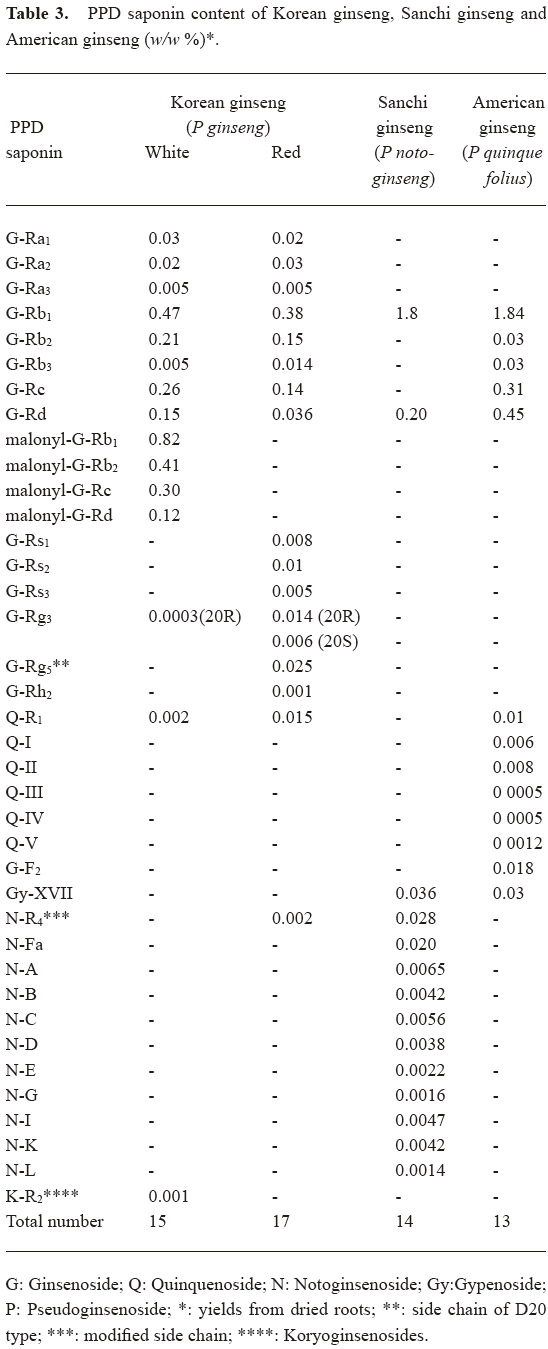
Full table
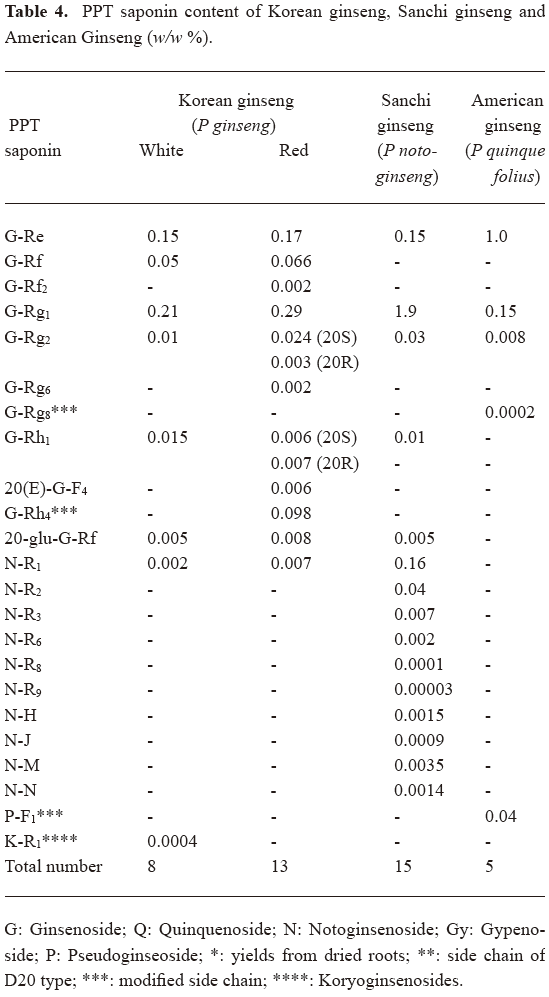
Full table
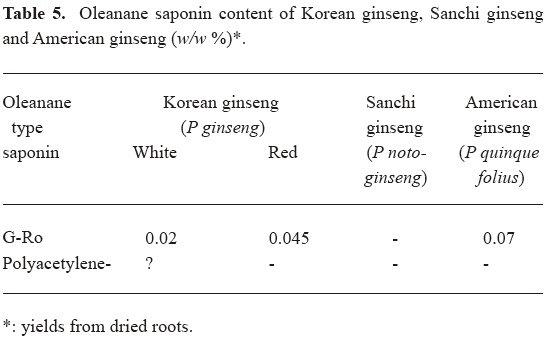
Full table
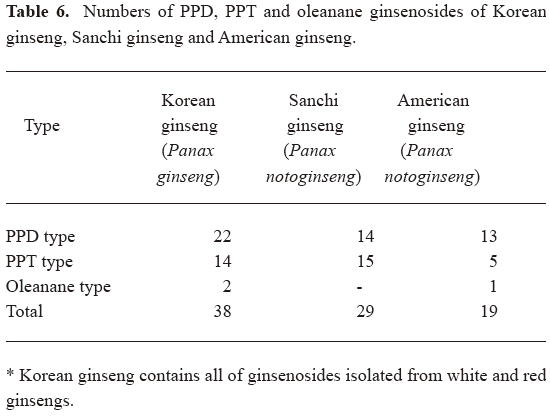
Full table
Korean researchers[81] made an analysis of aglycone compounds in the primary root, rootlet and root hair. The ratio of panaxadiol and panaxatriol is about 1.0 per primary root, 1.5 per rootlet and 0.1 per root hair. The amount of saponin content in rootlets is twice as great as that of the primary, whereas the amount of saponin content in root hair is about the same as the primary root. Nevertheless, root hairs and rootlets are not used for medicinal purposes, which is thought to be a result of the saponin content. Han[82] reported that when evaluating the medical effects of ginseng, it should be made using the correct ratio of panaxadiol and panaxatriol and absolute saponin content. This also applies to foreign ginsengs.
The high evaluation of Korean ginseng in the world market is not because of its mere appearance or manufacturing technology, but because of its medical effects. This may mean that the excellent efficacy of Korean ginseng bears relation to the ratio of panaxadiol and panaxatriol. The ratio of ginsenosides Rb1 and Rg1 contained in Korean ginseng is different from that of American ginseng or Notoginseng (Sanchi ginseng) (Table 7). The relative amount of Rg1 contained in American ginseng is very small, whereas that of Rg1 contained in Korean ginseng is roughly the same.
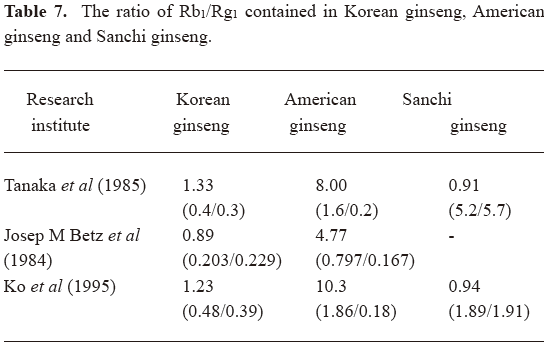
Full table
Non-saponin physiologically-active components Korean ginseng has important substances other than ginsenoside that show anti-tumor, anti-oxidative, anti-diabetic and anti-inflammatory effects, and even hematosis action.
Dr SI KIM[83] at Korea Ginseng and T Research Institute worked with Professor BJ AHN at Chungnam University College of Pharmacy to announce that the oil soluble ingredient contained in ginseng inhibited tumor growth in tested rats. These components are panaxydol, panaxynol and panaxytriol, and have displayed strong inhibitory effects on L1210 anti-tumor cells. Generally, polyacetylene compounds such as panaxydol, panaxynol and panaxytriol show anti-tumor and antioxidative effects[83,84], and the content of polyacetylene compounds in Korean ginseng (0.89 mg/g dw) is even greater than those of American (0.64 mg/g dw) and Sanchi ginseng (Notoginseng) (0.75 mg/g dw).
Phenol compounds such as maltol show anti-aging effects as a lipid peroxidation inhibitor. Maltol is a phenol compound specific to Korean red ginseng. Carbohydrates are extracted in a water solution, and make up 60%–70% of total extracts. Monosaccharide, disaccharide, and trisaccharide and polysaccharide, and polysaccharide such as panaxans A-U display a hypoglycemic effect, increased immune system and anti-ulcerative activity. Particularly, acid polysaccharides such as panaxan Q-U have inhibition activities against active toxohormone-L[44]. Korean ginseng has more acid polysaccharides than its American counterpart (Table 8).
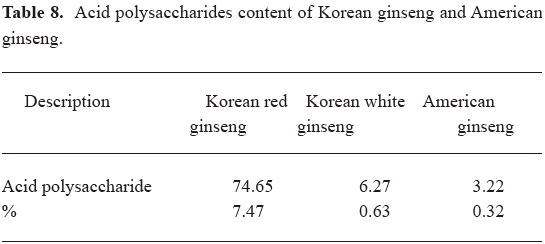
Full table
Among refined oil properties, there is ispinene, which acts as a pain reliever and anti-inflammatory drug, and ocinene, which is an active element against abnormal intestinal fermentation. Particularly, the importance of non-saponin properties came to be recognized by the findings of anti-diabetic components such as adenosine, acidic peptide and substance containing manganese, and non-saponin ingredients that have effective pharmacological activities. Before these reports, the importance of panaxydol and linoleic acid, inflammatory ingredients, have been emphasized. On top of those properties, Korean ginseng (Panax ginseng C A Meyer) contains properties having nitrogen such as protein and nucleic acid, essential amino acids and essential fatty acids. Notably, Korean ginseng still has more amino acids than American ginseng.
References
- Brekhman II. . Leningrad: Gosudaarst Isdat et Med Lit; 1957.
- Brekhman II, Dardymov IV. New substances of plantorigin which increase non-specific resistance. Annu Rev Pharmacol 1969;9:419-30.
- Bittles AH, Fulder SJ, Grant EC, Nichills MR. The effect of ginseng on lifespan and stress response in mice. Gerontology 1979;25:125.
- Zhuo DH. Preventive geriatrics: An overview from traditional Chinese medicine. Am J Chin Med 1982;10:32.
- Park JK, Nam KY, Hyun HC, Jin SH, Chepunov SA, Chepunov NE. Effect of ginseng triol saponin fractions on the spatial memory functions studied with 12-arm radial maze. Korean J Ginseng Sci 1994;18:32-8.
- Saito H, Nishiyama N. Effects of ginseng and its saponins on experimental amnesis in mice and on cell cultures of neurons. Proceedings of the 5th International Ginseng Symposium; 1988. Seoul, Korea: Korean Society of Ginseng.
- Zhang JT, Qu ZW, Liu Y, Deng HL. Preliminary study on antiamnestic mechanism of ginsenoside Rg1 and Rb1. Clin Med J 1990;103:932-8.
- Zhang G, Liu A, Zhou Y, San X, Jin T, Jin Y, et al. Ginsenoside- Rg2 protects memory impairment via anti-apoptosis in a rat model with vascular dementia. J Ethnopharmacol 2008;115:441-8.
- Lee ST, Chu K, Kim JM, Park HJ, Kim M. Cognitive improvement by ginseng in Alzheimer’ disease. Proceedings of the 9th International Ginseng Symposium; 2006. Geumsan, Chungnam, Korea, Korean Society of Ginseng.
- Kennedy DO, Scholey AB. Ginseng: potential for the enhancement of cognitive performance and mood. Pharmacol Biochem Behav 2003;75:687-700.
- Kennedy DO, Reay JL, Scholey AB. Effects of 8 weeks administration of Korean extract on the mood and cognitive performance in healthy individuals. Proceedings of the 9th International Ginseng Symposium; 2006, Geumsan, Chungnam, Korea, Korean Society of Ginseng.
- Seo YJ, Shim EJ, Kwon MS, Choi OS, Yang JW, Choi SS, . Anticiceptive effects of ginsenosides injected intracerebroventricularly or intrathecally in various pain models. Proceedings of the 9th International Ginseng Symposium; 2006, Geumsan, Chungnam, Korea, Korean Society of Ginseng.
- Kamangar F, Gao YT, Shu XO, Kahkeshani K, Ji BT, Yang G, et al. Ginseng intake and gastric cancer risk in the Shanghai Women’s Health Study cohort. Cancer Epidemiol Biomarkers Prev 2007;16:629-30.
- Yun TK. Experimental and epidemiologic evidence on non-organ specific cancer preventive effect of Korean red ginseng and identification of active compounds. Mutat Res 2003;523–524:63-74.
- Yun TK, Choi SY. A case-control study of ginseng intake and cancer. Int J Epidemiol 1990;19:871-6.
- Yun TK, Choi SY. Preventive effect of ginseng intake against various human cancers: A case-control study on 1987 pairs. Cancer Epidemiol Biomakers Prev 1995;4:401-8.
- Ahn YK, Kim JY, Chung JG, Kim JH, Goo JD. The effect of Korean ginseng on the immunotoxicity of mitomycin C. Yakhak Hoeji 1987;31:355-60.
- Fukushima S, Wanibuchi H, Li W. Inhibition by ginseng of colon carcinogenesis in rats. J Korean Med Sci 2001;16:S75-80.
- Hwang WI, Lee SD, Han YN, Lee YT. A study on the cytotoxic activity of Korean red ginseng against cancer cells. Proceedings of the 6th Internationa1 Ginseng Symposium; 1993. Korea Ginseng & Tobacco Research Institute, Korea.
- Kikuchi Y, Sasa H, Kita T, Hirata J, Tode T. Inhibition of human ovarian cancer cell proliferation in vitro by ginsenoside-Rh2 and adjuvant effects to cisplatin in vivo. Anticancer Drugs (England) 1991;2:63-7.
- Liu W K, Xu SX, Che CT. Anti-proliferative effect of ginseng saponins on human prostate cancer cell line. Life Sci 2000;67:1297-306.
- Matsunaga H, Katano M, Yamanoto H, Fujito H, Mori M, Takata M. Cytotoxic activity of polyacetylene compounds in Panax ginseng CA Meyer. Chem Pharm Bull 1990;38:3480-2.
- Odashima S, Nakayabu Y, Honjo N, Abe H, Arichi S. Induction of phenotypic reverse transformation by ginsenosides in cultured Morris hepatimacells. Eur J Cancer 1979;15:885-92.
- Popovich DG, Kitts DD. Ginsenosides 20(S)-protopanaxadiol and Rh2 reduce cell proliferation and increase sub-G1 cells in two cultured intestinal cell lines, int-407 and caco-2. Can J Physiol Pharmacol 2004;82:183-90.
- Wang Z, Zheng Q, Liu K, Li G, Zheng R. Ginsenoside Rh2 enhances antitumor activity and decreases the genotoxic effect of cytophosphamide. Basic Clin Pharmacol Toxicol 2006;98:411-15.
- Xu TM, Xin Y, Cui MH, Jiang X, Gu LP. Inhibitory effect of ginsenoside Rg3 combined with cyclophosphamide on growth and angiogenesis of ovarian cancer. Clin Med J 2007;120:584-8.
- Yun TK, Lee YS, Lee YH, Kim SI, Yun HY. Anticarcinogenic effect of Panax ginseng C. A. Meyer and identification of active compounds. J Korean Med Sci 2001;16:S6-18.
- Kumar A, Kumar M, Panwar M, Samarth R, Park TY, Park MH, . Evaluation of anticancer action of ginsenoside Rp1 and its molecular mechanism. Proceedings of the 9th International Ginseng Symposium; 2006, Geumsan, Chungnam, Korea, Korean Society of Ginseng.
- Park JD, Shin HJ, Kwak YS, Wee JJ, Song YB, Kyung JS, . Partial chemical structure and immunomodulating antitumor activities of RGAP (red ginseng acidic polysaccharide) from Korean red ginseng. Proceedings of the 9th International Ginseng Symposium; 2006, Geumsan, Chungnam, Korea, Korean Society of Ginseng.
- Suh SO, Kim J, Boo YJ, Park JM, Kim J. Prospective study for Korean red ginseng extract as an immune modulator following a curative surgery in patients with advanced colon cancer. Proceedings of the 9th International Ginseng Symposium; 2006, Geumsan, Chungnam, Korea, Korean Society of Ginseng.
- Mochizuki M, Yoo YC, Azuma I. Inhibitory effect of tumor invasion and metastasis by saponins, 20(R)- and 20(S)-ginsenoside-Rg3, or red ginseng. Proceedings of the Korea-Japan Ginseng Symposium; 1995, Seoul, Korea, Korea Ginseng & T Research Institute.
- Mochizuki M, Yoo YC, Matsuzawa K, Sato K, Saiki I, Tono-Oka S, et al. Inhibitory effect of tumor metastasis in mice by saponin, ginsenoside-Rb2, 20(R)- and 20(S)-ginsenoside-Rg3, of red ginseng. Biol Pharm Bull 1995;18:1197-202.
- Kubo M, Tong CN. Influence of the 70% methanolic extract from red ginseng on the lysosome of tumor cells and on the cytocidal effect of mitomycin C. Planta Med 1992;58:424-8.
- Noh HT, Rhee YE, Choi YB, Park MJ. Clinical study for effects of ginseng on CDDP-treated cancer patients. Choesin Uihak 1992;35:40-6.
- Park JD, Kim DS, Kwon HY, Son SK, Lee YH, Baek NI, et al. Effects of ginseng saponin on modulation of multidrug resistance. Arch Pharm Res 1996;193:213-8.
- Lai DM, Tu YK, Liu IM, Chen PF, Cheng JT. Mediation of beta-endorphin by ginsenoside Rh2 to lower plasma glucose in streptozotocin-induced diabetic rats. Planta Med 2006;72:9-13.
- Sievenpiper JL, Sung MK, Di Buono M, Seung-Lee K, Nam KY, Arnason JT, et al. Korean ginseng rootlet decreases acute postprandial glycemia: Results from sequential preparation- and dose-finding studies J Am Coll Nutr 2006;25:100-7.
- Vuksan V, Sievenpiper JL, Xu Z, Beljan-Zdravkovic U, Jenkins AL, Arnason JT, . A role for ginseng in the control of postprandial glycemia and type 2 diabetes. Proceedings of the 8th International Symposium on Ginseng; 2002, Seoul, Korea, Korean Society of Ginseng.
- Yokozawa T, Kobayashi T, Oura H, Kawashima Y. Studies on the mechanism of hypoglycemic activity of ginsenoside-Rb2 streptozotocin-diabetic rats. Chem Pharm Bull 1985;33:869-72.
- Yokozawa T, Oura H, Kawashima Y. Effect of administration of ginsenoside-Rb2 in diabetic rats: In terms of carbohydrate and lipid metabolites. Chem Pharm Bull 1987;35:4872-7.
- Yokozawa T, Oura H. Facilitation of protein biosynthesis by ginsenoside-Rb2 administration in diabetic rats. J Nat Prod 1990;53:1514-18.
- Ando T, Muraoka T, Okuda H, Yamasaki N. Preparation of insulin-like peptides from g. Proceedings of Wakan-Yaku Ginseng Symposium. Gobe, Japan Proc Symp Wakan-Yaku 1979; 12: 15–19.
- Lee WK, Kao ST, Liu IM, Chen JT. Increase of insulin secretion by ginsenoside Rh2 to lower plasma glucose in Wistar rats. Clin Exp Pharmacol Physiol 2006;33:27-32.
- Okuda H, Lee SD. Biological activities of non-saponincompounds isolated from Korean red ginseng. Proceedings of the International Symposium on Korean Ginseng, 1990; Seoul, Korea. Korea Ginseng & T Research Institute.
- Takaku T, Kameda K, Matsuura Y, Sekiya K, Okuda H. Studies on insulin-like substances of Korean red ginseng. Planta Med 1990;56:27-30.
- Huh K, Jang BS, Park JM. Protective effect of ginseng on bromobenzene-induced hepatoxicity in mice. Korean J Ginseng Sci 1988;12:114-20.
- Lee FC, Park JK, Kim EK, Ko JH, Lee JS, Kim KY. The role of Panax ginseng in detoxification of xenobiotics. Proceedings of the 4th International Ginseng Symposium; 1984. Seoul, Korea, Korea Ginseng & T Research Institute. Korea Ginseng Research Institute.
- Mizoguchi Y, Protective effect of ginseng saponin. Report of Ginseng Research Association: 1988. p 46–48.
- Saxena PN, Mahour K. Analysis of hepatoprotection by following mercuric chloride intoxication in albino rat. Proceedings of the 9th International Ginseng Symposium; 2006, Geumsan, Chungnam, Korea, Korean Society of Ginseng.
- Song JH, Park MJ, Kim E, Kim YC. Effects of Panax ginseng on galactosamine-induced cytotoxicity in primary cultured rat hepatocytes. Yakhak Hoeji 1990;34:341-7.
- Matsuda H, Samukawa K, Kubo M. Anti-hepatitic activity of ginsenoside Ro. Planta Med 1991;57:52-5.
- Vuksan V, Stavro M, Woo M, Leiter LA, Sung MK, Sievenpiper JL. Korean red ginseng () can lower blood pressure in individuals with hypertension: a randomized controlled trial. Proceedings of the 9th International Ginseng Symposium; 2006, Geumsan, Chungnam, Korea, Korean Society of Ginseng
- Kang SY, Schini-Kerth VB, Kim ND. Ginsenosides of the protopanaxatriol group cause endothelium-dependent relaxation in the rat arorta. Life Sci 1995;56:1577-86.
- Kim ND, Kang SY, Schini-Kerth VB. Ginsenosides evoke endothelium-dependent vascular relaxation in rat aorta. Gen Pharmac 1994;25:1071-7.
- Saito H, Bao TT. Effect of red ginseng on mice exposed to various stress. Proceedings of the 4th International Ginseng Symposium; 1984, Seoul, Korea, Korea Ginseng & T research Institute.
- Kim CC. Influence of Panax ginseng on the response of stressful stimuli in the experimental animal exposed to various stress. Korean J Ginseng Sci 1979;3:168-86.
- Kaneko H, Nakanishi K, Murakami A, Aidoh H, Kuwashima K. The acute effects of massive dose of red ginseng on healthy adults under the condition of cold stress. Proceedings of the Korea-Japan Ginseng Symposium; 1996, Seoul, Korea, Korea Ginseng & T Research Institute.
- Zhang JT, Chui DH, Liu GZ. The chemistry, metabolism and biological activities of ginseng. Beijing: Chemical Industry Press; 2006.
- Zhang JT, Chui DH, Liu GZ. The chemistry, metabolism and biological activities of ginseng. Beijing: Chemical Industry Press; 2006.
- El-Kady AA, Hosain ARM, Park MH, Kim YT, Park HH, Abdel-Wahhab MA. Efficacy of Panax ginseng extract standardized with ginsenoside Rg3 against oxidative stress of PCBs in rats. Proceedings of the 9th International Ginseng Symposium; 2006, Geumsan, Chungnam, Korea, Korean Society of Ginseng.
- Ogita S, Samugawa K. Clinical effectiveness of Korean ginseng on patients with climacteric disturbances. Ginseng Rev 1994;18:95-7.
- Andrade E, Mesquita AA, Claro JA, Andrade PM, Ortiz V, Paranhos M, et al. Study of the efficacy of Korean red ginseng in the treatment of erectile dysfunction. Asian J Androl 2007;9:241-4.
- Choi HK, Seong DH. Effectiveness for erectile dysfunction after the administration of Korean red ginseng. Korean J Ginseng Sci 1995;19:17-21.
- Choi HK, Seong DH, Rha KH. Evaluation of clinical efficacy of Korean red ginseng for erectile dysfunction by international index of erectile function (IIEF). Int J Ginseng Res 2001;25:112-7.
- Choi YD, Rha KH, Choi HK. In vitro and in vivo experimental effect of Korean red ginseng on erection. J Urol 1999;162:1508-11.
- Salvati G, Genovesi G, Marcellini L, Paolini P, De Nuccio I, Pepe M, et al. Effects of Panax ginseng C.A. Meyer saponins on male fertility. Panminerva Med 1996;38:249-54.
- Cho YK. Change of serum β2-microglobulin, p24 antigen and CD4+ T lymphocyte in persons with human immunodeficiency virus infection after azidothymidine Treatment. J Korean Soc Microbiol 1993;28:409-17.
- Cho YK, Kim YK, Lee I, Choi MH, Shin YO. The effect of Korean red ginseng (KRG), zidovudine, and the combination of KRG and ZDV on HIV-infected individuals. J Korean Soc Microbiol 1996;31:353-60.
- Shin YO. Effects of Korea red ginseng on immunological markers of persons with human immunodeficiency virus. Proceedings of the 6th International Ginseng Symposium. Seoul, Korea, Korea Ginseng & T Research Institute; 1993: 52–6.
- Cho YK, Lim JY, Jung YS, Oh SK, Lee HJ, Sung H. High frequency of grossly deleted nef genes in HIV-1 infected long-term slow progressors treated with Korean red ginseng. Curr HIV Res 2006;4:447-57.
- Abdel-Wahhab MA, Ahmed HH. Protective effects of Korean Panax ginseng against chromium VI toxicity and free radical generation in rats. J Ginseng Res 2004;28:11-7.
- Chung YH, Kim KW, Oura H. Effects of ginsenoside Rb2 on the anti-oxidants in senescence-accelerated mice(SAM-R/1). Proceedings of the 6th Internationa1 Ginseng Symposium; 1993, Korea Ginseng & Tobacco Research Institute, Korea.
- Han BH, Han YN, Park MH. Chemical and biochemical studies on antioxidant components. Advances in Chinese Medicinal Materials Research. Philadelphia: World Scientific Co; 1985.
- Kim HY, Chen X, Gillis CN. Ginsenosides protect pulmonary vascular endothelium against free radical-induced injury. Biochem Biophys Res Commun 1992;189:670-6.
- Kim YK, Gua Q, Packer L. Free radical scavenging activity of red ginseng aqueous extracts. Toxicology 2002;172:149-56.
- Kim (Jun) HY. Lee YH, Kim SI. Effects of polyacetylene compounds from Panax ginseng C.A. Meyer on CCI4 induced lipid peroxidation in mouse liver. Korean J Toxicol 1988;4:3.
- Wang XM, Qi Y, Sun CW, Zhong GG, Jiang Y, Qiu YH. Single calcium channel analysis and electron spin resonance (ESR) spectral study on the mycocardial effects of ginsenoside Rb2. Chung Guo Yao Tsa Chih 1994;19:621-4.
- Oura H, Oita Y. Effect of Korean red ginseng powder on the survival rate of rat. Ginseng Rev 1989: 228–37.
- Choi KT. Comparison of characteristics in Korean ginseng and American ginseng. Report of Korea Ginseng and Tobacco Research Institute, 2002.
- Park JD. Recent studies on the chemical constituents of Korean ginseng (Panax ginseng C A Meyer). Reviews in Ginseng Research (I), Korean Society of Ginseng; 2007: 32–45.
- Woo LK, Han BH. Saponin cotent of Korean ginseng. Korean J Pharmacol 1973; 4.
- Han BH. Chemical components of Korean ginseng. Korean Ginseng Symposium; 1974, Seoul, Korea, Korea Monopoly Research Institute.
- Kim SI, Lee YH, Kang KS. 10-Acetylpanaxytriol, a newcytotoxic polyacetylene from Panax ginseng. Yakhak Hoeji 1989;33:118.
- Ahn BZ, Kim SI, Kang KS, Kim YS. The action of cytotoxic components of Korean ginseng against L1210 cells and their structure-activity relationship. Proceedings of the 5th International Ginseng Symposium; 1988, Seoul, Korea, Korea Ginseng & T Research Institute.
